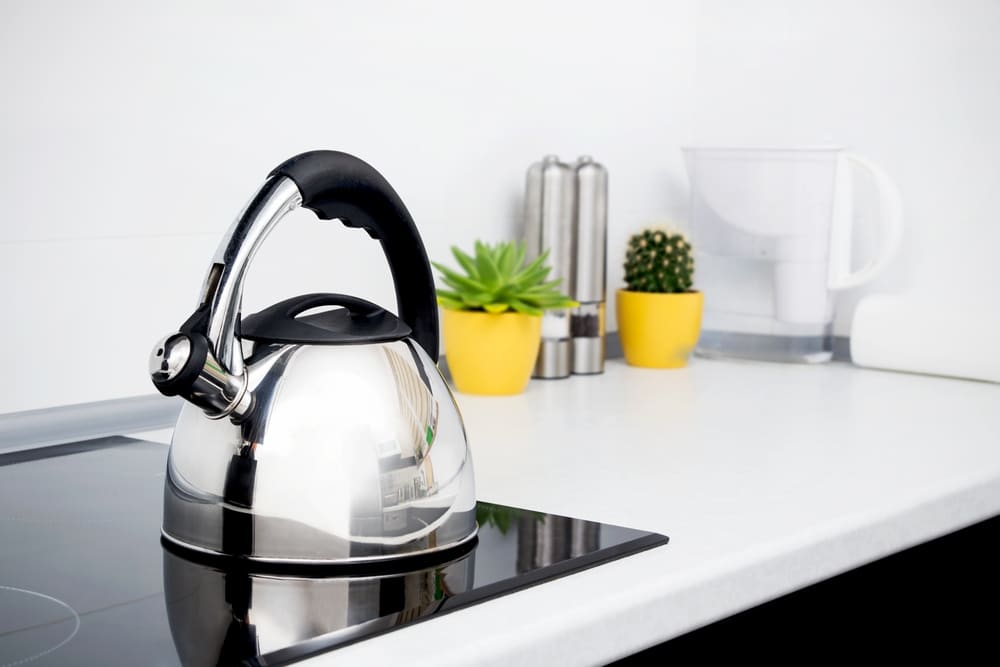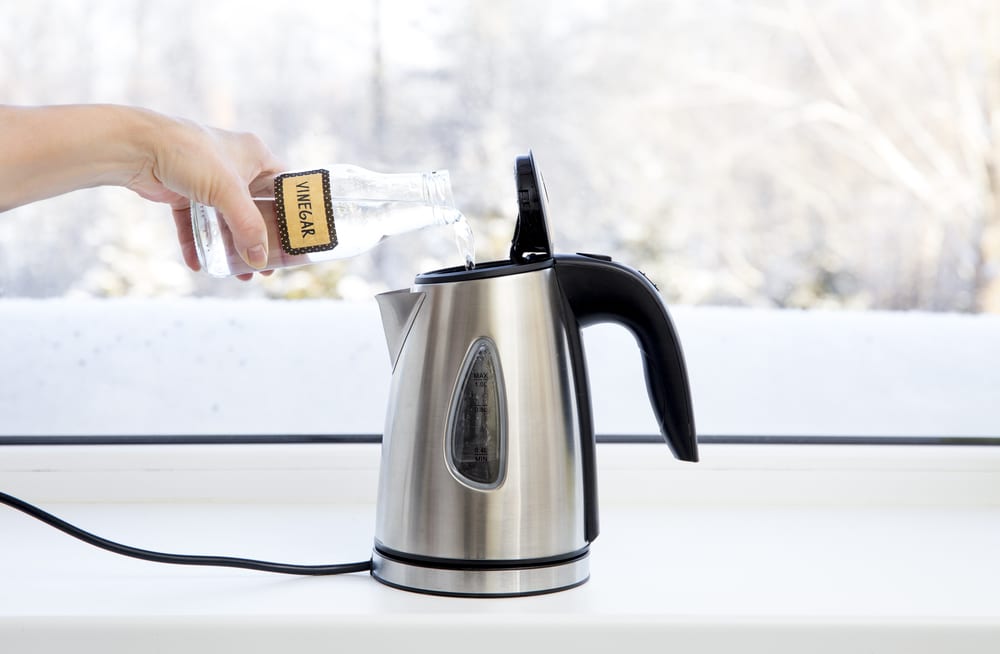Last Updated on January 10, 2023
Having a hot cuppa is a wonderful way to start or end your day, no matter the time of year. However, as you use your kettle regularly, you may notice the build-up of small deposits on the interior walls or around the heating element.
These tiny calcium and limescale sediments can appear on both traditional stovetop and electric type kettles. While they aren’t harmful to you, they can be unsightly and may even change the flavour of your favourite tea.
If left on the interior of your electric kettle for too long, these limescale deposits can also damage the heating element and reduce the lifespan of your kettle. That’s why it’s important to learn how to descale a kettle on a regular basis. Electric kettles will have a much longer usable life, and they will remain pristine and appealing to look at.
What is Limescale?
Limescale is the catch-all term for a range of mineral build-ups on the interior of your kettle as hard water boils out in the form of steam. These minerals left behind from the hard water evaporation can be calcium, magnesium, copper, and more.
If you live in one of the many hard water areas across the country, you will undoubtedly have experience with limescale before too long. Ingesting limescale is not harmful to you, though it can alter the flavour of your favourite tea and will even be very unsightly as you see small white flakes of limescale floating around in your cuppa.
Limescale is very common on kettles with a heating element in the bottom. These mineral build-ups will form on the metal base plate near the heating element or in other areas where hot water evaporates and leave behind these solids.
Why Should You Descale Your Kettle?
Leaving a coating of limescale on your kettle is unsightly and unappealing. Over time, you may notice small white flakes of stuff floating in your tea. While it is not harmful to ingest these flakes, they can change the flavour of your drink to have a more metallic taste. You will surely want to know how to descale a kettle when this happens.
An excessive coating of limescale around the heating element of your kettle can reduce the effectiveness and efficiency of the heating element. This leads to improperly warmed drinks and a shorter lifespan for the kettle itself. If you start to notice this type of build-up, it’s time to learn how to clean a kettle.
Descaling your kettle is a simple process that should be done every two to three months, depending on how often you use your kettle. Whether you want to learn how to descale a kettle with lemon juice, citric acid or a vinegar solution, rest assured that there are various household items you can use for this process. That said, you can also find commercially available acids to help cut through the limescale and thoroughly clean the interior of your metal or plastic kettles.
Descaling a Kettle With Bicarbonate of Soda
This is a quick and simple method for descaling a kettle naturally, as long as the coating of limescale has not gone too far. Bicarbonate of soda, or baking soda, is a great cleaning option to use once a month to remove limescale but may not be effective for heavy staining.
Step 1: Unplug Your Kettle
Ensure your kettle is completely cool from any prior usage. If using an electric kettle, make sure it is fully unplugged from any power source to prevent the risk of electric shock to you or damage to your kettle.
Step 2: Add Water and Baking Soda
Fill your kettle halfway with fresh water from the tap. Add a heaping teaspoon of baking soda to the kettle. Swirl the liquid around for a minute or two and give the powder some time to blend with the water.
Step 3: Let it Boil
Start your kettle heating up and allow the water and bicarbonate of soda mixture to boil. For traditional stovetop kettles, let it boil for one to two minutes. For electric-powered kettles with an automatic shutoff timer, allow it to come to a boil and shut off on its own.
Step 4: Let it Cool, then Rinse
Allow the hot water and vinegar mixture to sit in your kettle for at least half an hour and up to one hour for difficult build-up. After this time, the kettle should be cool and safe to handle. Give it another swirl, pour the liquid down the drain, and rinse your kettle under cold water. If you notice any remaining limescale around the heating elements, use a damp sponge to scrub it away before the next step.
Step 5: Check for Remaining Limescale
If you only had minor limescale build-up, the bicarbonate of soda should have been able to loosen it enough to remove it. If you notice a difficult coating of limescale still clinging to the sides, bottom, or heating coil, repeat the process a second time or move on to a more aggressive cleaning method like the ones below.
Descaling a Kettle With White Vinegar
White vinegar is a very common household acid that can be great to descale your kettle, especially if it has calcium carbonate build-up. If the bicarbonate of soda method was not effective to descale your favourite kettle, consider learning how to descale a kettle with vinegar.
Step 1: Unplug Your Kettle
Be sure to unplug your kettle from the power source completely. Allow both stovetop and powered kettles to cool down before you start to clean them fully. Release the lid and the removable limescale filter, if present. Rinse the kettle with cold water straight from the tap to remove any loose flakes of limescale.
Step 2: Add Water and Vinegar
Fill your kettle one-fourth of the way with cold water. Add an equal amount of white vinegar, so your kettle is halfway filled with liquid. Swirl the kettle around, so the two liquids mix together.
Step 3: Let it Boil
Place your traditional kettle back on the stove, or plug in your powered kettle to a power source, and allow the kettle to start heating the liquid inside. Let the water and vinegar solution boil for a short time; one to two minutes should be plenty.
Step 4: Let it Cool, then Rinse
Allow the hot water and vinegar mixture to sit in your kettle for at least half an hour and up to one hour for difficult build-up. After this time, the kettle should be cool and safe to handle. Give it another swirl, pour the liquid down the drain, and rinse your kettle under cold water. If you notice any remaining limescale around the heating elements, use a damp sponge to scrub it away before the next step.
Step 5: Deodorise the Vinegar
While your kettle may look new again, it’s important to ensure your next kettle of tea doesn’t have a vinegar aftertaste. Refill the kettle halfway with clean water from the tap, and allow it to come to a boil. This helps deodorise the vinegar from the kettle and ensures you won’t have any remaining flavour or odour of vinegar in your next cuppa.
Descaling a Kettle With a Commercial Product

You could use a wide range of commercial cleaning options if the bicarbonate of soda and the vinegar options didn’t work for you. These commercial cleaning products usually use a much more aggressive acetic acid mixture to remove limescale build-ups from most kettles.
However, when using a commercial kettle limescale remover, always follow the manufacturer’s instructions on the packaging. This will not only keep you safe, but it will also help you get the best results during the descaling process.
Also, check the ingredients and environmental warnings on the packaging. Some commercial cleaning products can simply be washed down the drain after you have used them to clean your kettle, while others may need to be disposed of differently.
In general, most commercial cleaning products for kettles are safe to be rinsed down the drain after using them, and you can toss the sachets in the bin without any additional safe handling methods.
Good as New
Learning how to descale a kettle is not a complicated process, and it can be done for both electric kettles and traditional stovetop kettles. Keeping your kettle free of limescale build-up will help ensure your kettle remains operational for a long time and can also guarantee the best flavour from your tea.
Having a kettle with limescale build-up is unsightly and can give a metallic flavour to your next cuppa. Once you learn how to remove limescale from a kettle, you’ll be back to enjoying a delicious and flavorful tea!
Paul is the type of person who never met a problem he couldn’t fix. He can always be found tinkering with something in his house, even if it isn’t broken! His tips and tricks are often shared on our site. He’s the one you call when something breaks because he has been known to improvise fixes for everything from leaky faucets to malfunctioning dryers.

